It has been said that the only constant on Louisiana's coast is change, and the Saltening is yet another evolution of that change.
So, what is this "saltening"? What does it mean for Louisiana's inshore fishing? For speckled trout and redfish?
Those questions and more are explored in this article detailing this natural phenomenon. To get started we must briefly review what my previous article about The Freshening established.
If we are to know where we are, then we must know where we have been, and that demands knowing what happened from 2011 to 2020.
A Brief Review of The Freshening
During The Freshening, Louisiana's coast saw an unprecedented — yet record-breaking — amount of precipitation and river water flood her coast.
This happened from 2011 to 2020, and during this time the coastal salinity and water clarity was radically changed.
Specifically, the freshwater line was pushed out much further from where it previously resided deeper inland.
To reflect this, I've modified the below Hydrocoast maps, using a purple line to denote where the freshwater line resides.
Hydrocoast Freshwater Line - May 2014
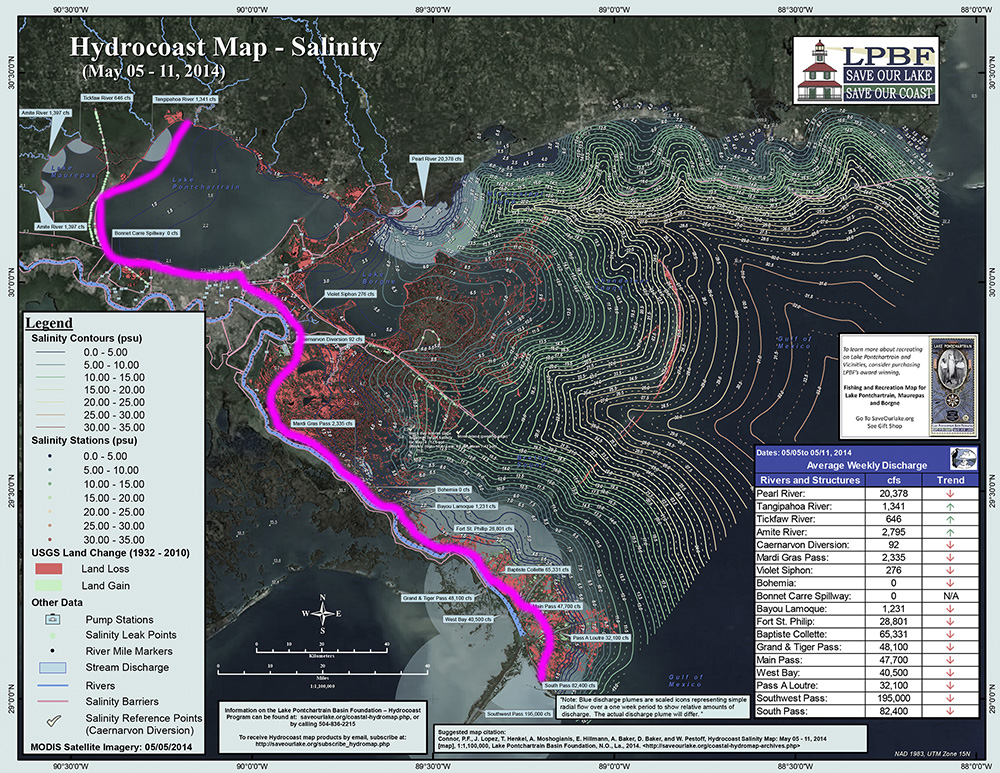
Click to Enlarge
Hydrocoast Freshwater Line - May 2019
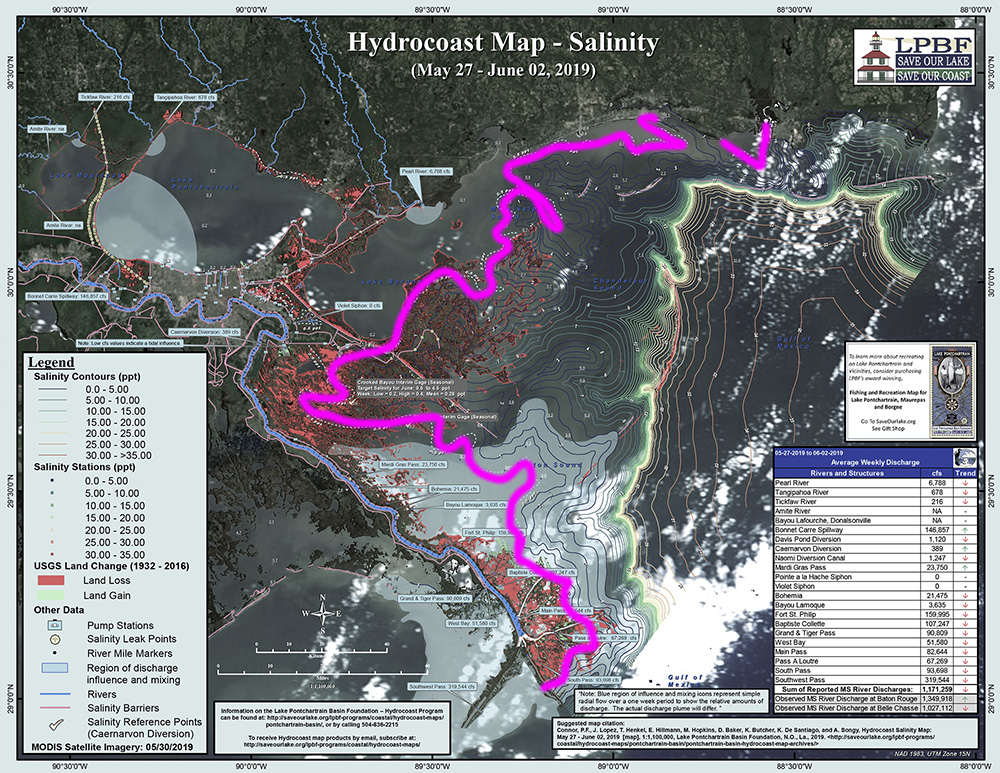
Click to Enlarge
You don't have to be a scientist to see the giant change in salinity in the space of five years and not to mention that the second spillway opening of 2019 was not yet underway!
Additionally, you can see that the gradient of brackish water was far more spread out in 2014, whereas in 2019 it was much more compacted.
In short, there's less saltwater and more dirty river water in 2019. There's a legend below for your convenience.
Additionally, the above pictures are only 1,000 pixels wide, the full resolution PDF files can be found here for May 2014 and here for May 2019, for your perusal.
They are too large in size to put on this page, but they are more detailed in denoting the location and amount of salinity due to their increased resolution.
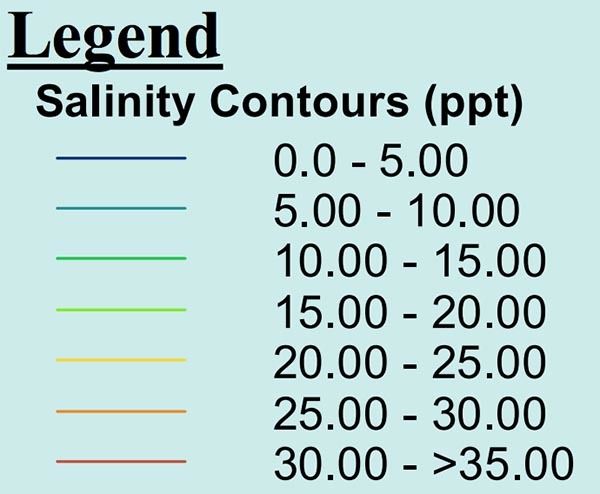
Quick Note On These Hydrocoast Maps
It would be better if I had a salinity map from before 2011 to really depict just how much saltier (and cleaner) coastal waters were before the Mississippi River (and surrounding rivers) rose up.
Alas, I do not. Hydrocoast was not yet a thing at that point in time and, even if it were, I still do not have that map.
However, the 2014 salinity map still does a good job depicting how much the coast has changed, especially considering that the bulk of The Freshening happened in that period of time from 2014 to 2019.
Getting back on track: this change in salinity radically altered Louisiana's different basins, changing where various denizens of the marsh spawn, feed and grow.
The most obvious impact to inshore anglers has been the prolific drop in the speckled trout population and, to commercial fishermen, the 90-100% mortality rate of oyster reefs in locations such as the Biloxi Marsh.
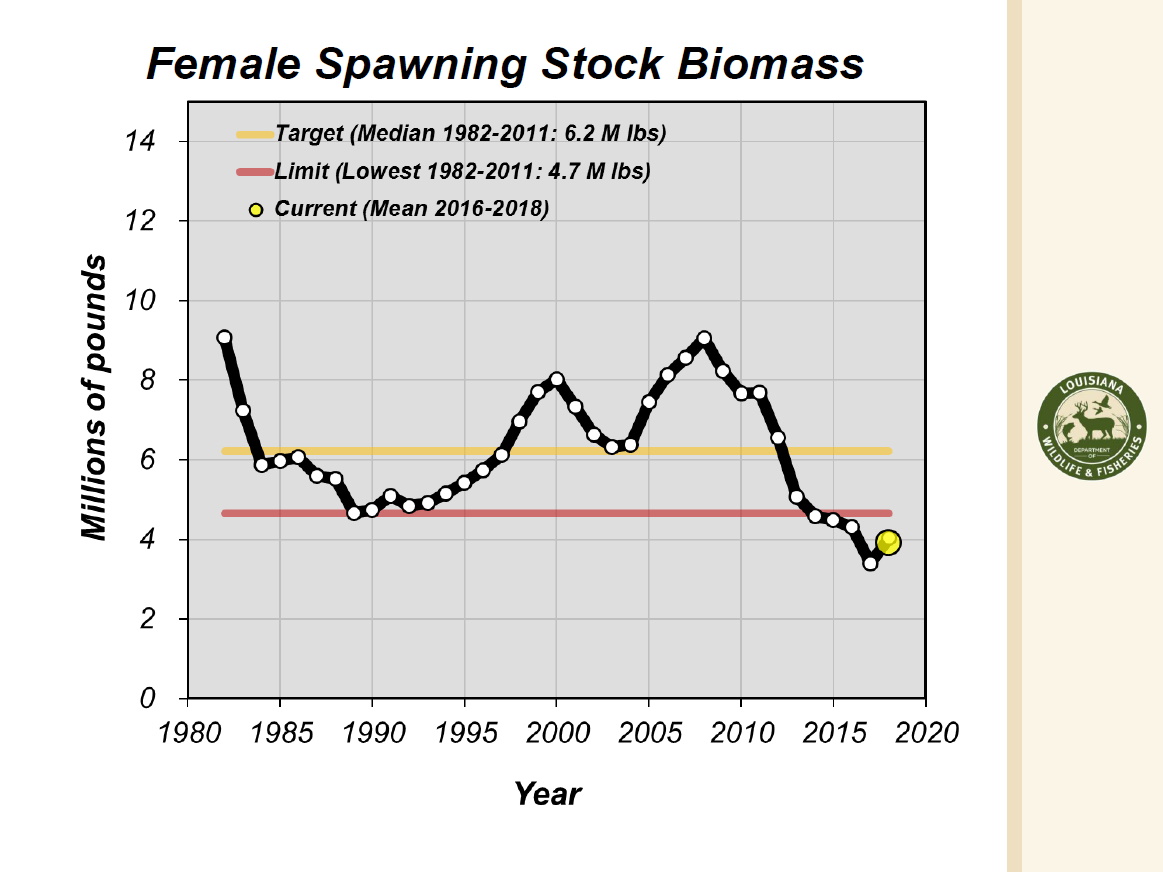
The speckled trout fishing took a dump. Anglers with clear memory recall this, and the science backs it up.
So, The Freshening was awful. It really sucked. It was the inevitable consequence of gravity and a lot of precipitation.
Now, it is over.
Okay, so now we are all caught up. Let's move on to what I believe is currently happening on Louisiana's coast:
The Freshening Is Over, Now The Saltening Begins
Once again, change is afoot. Things are drier. The rivers have gone down and stayed down, with that phenomena beginning in 2020 when we did not have a spillway opening.
Various bodies of water along Louisiana's coast are quite literally becoming saltier, and that is why I have dubbed this new era "The Saltening".
It is prolific, stretching across Louisiana's coast, as evidenced in these salinity charts shown below.
I think this change is more than just "things going back to normal". I think that what we are seeing is a radical change in direction.
Below are charts for Bay Gardene near the Mississippi River and Vermilion Bay near the Atchafalaya River, pulled from the respective United States Geological Survey stations at those locations.
The data below depicts salinity at those two locations for the years 2019, 2022 and 2023.
Bay Gardene Salinity 2019 to June 2023
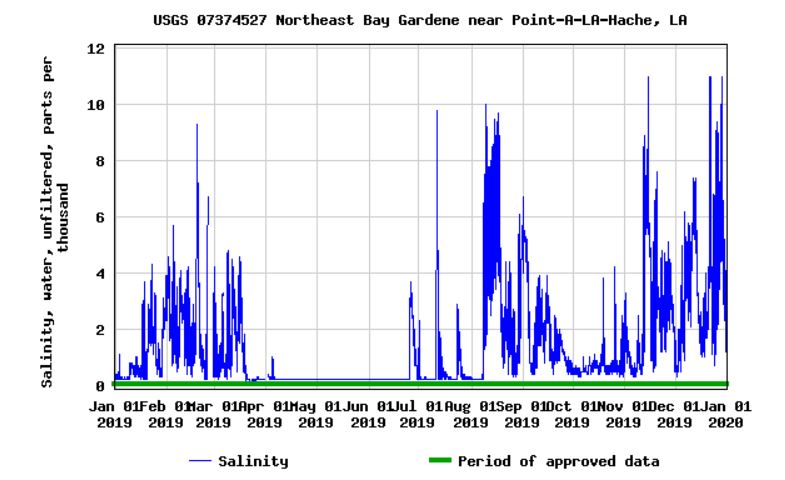
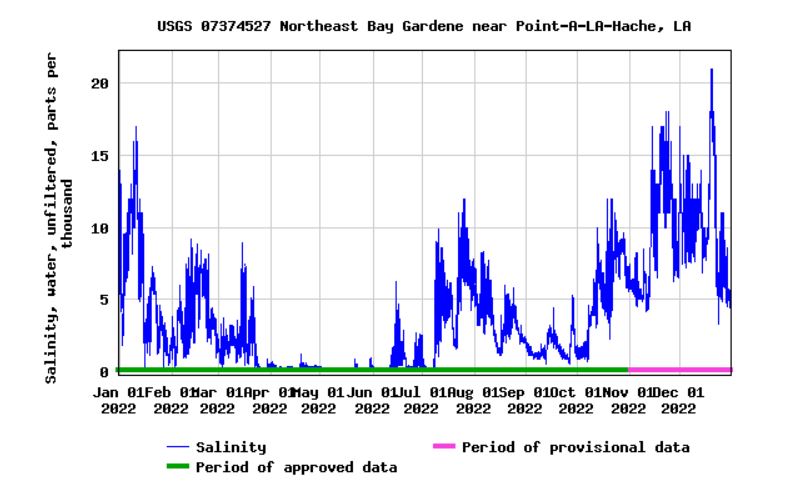
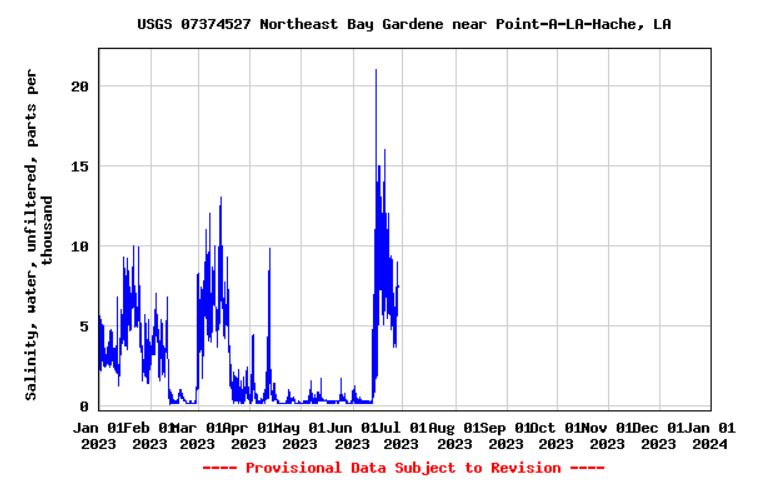
Just a reminder: be sure to look at the y-axis for each chart and note that its values are not always the same from chart to chart, indicating that peaks and lows in salinity are in fact much greater or lower depending on which chart you're looking at.
Vermilion Bay Salinity 2019 to June 2023
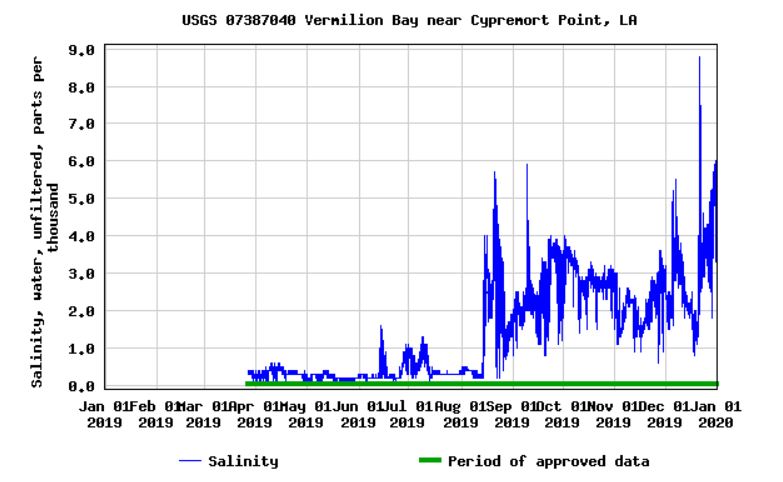
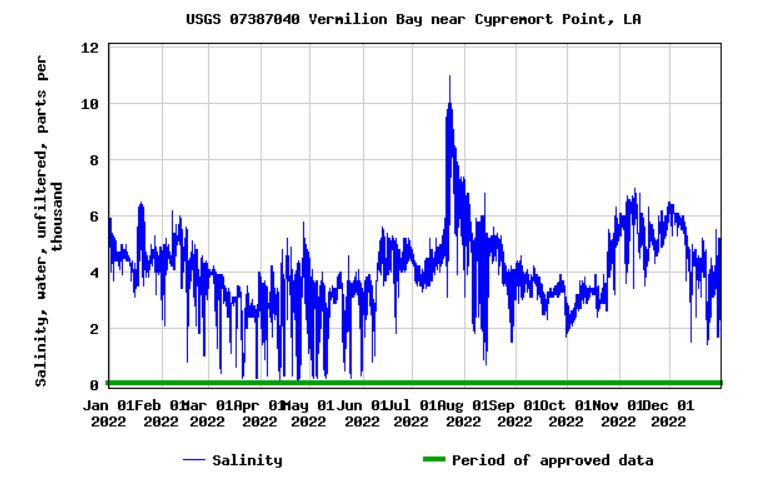
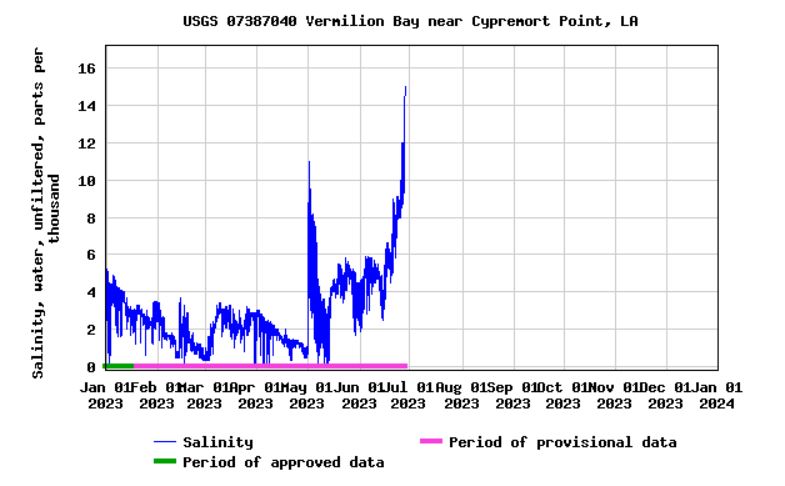
Now that you have looked at these charts, you can see how much fresher things were when the rivers raged high in 2019.
If you take time to thumb through all the years from 2011 to 2020, that is pretty much what you see: river water completely blowing out the salinity (and associated saltwater species).
But, note how much the salinity comes up in 2022 and especially here and now in 2023 (the time this blog post was written).
That right there is The Saltening kicking into gear!
Oh, and one other note: if you do not know here to source this salinity information and how to use it, then I strongly suggest taking my course Fishing Trip Planning Resources & How To Use Them.
Where are Hydrocoast maps for 2023?
By now you may be wondering where there are salinity maps to depict The Saltening, just as we used them to depict The Freshening.
Well, there aren't any.
Hydrocoast was discontinued some time ago due to lack of funding, but certainly not lack of interest. It is sad and I wish our state paid more attention to measuring and monitoring our coast.
These Other Signs Could Indicate A Saltening Has Begun
So, obviously it's saltier to some degree, but what else is there?
Well, it's worth pointing out that this year, in April 2023, the Mississippi River did something it has not done in a very long time: she went down from double digits to single digits in April and did not come back up. In April.
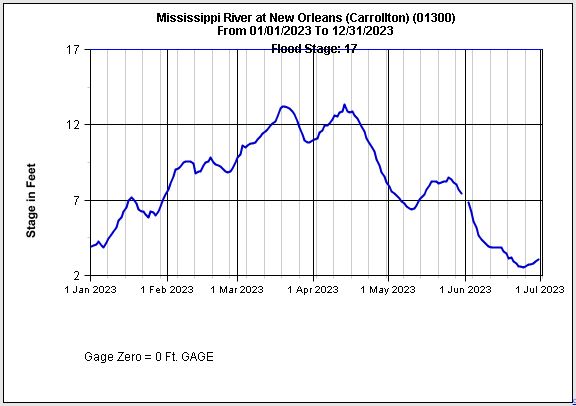
When you look at when she typically comes down over the years, you'll see that she does so in July (charts further down depict this).
But this year in 2023 we got a head start in April.
That has not happened since 1988!! (though 2012 came pretty close)
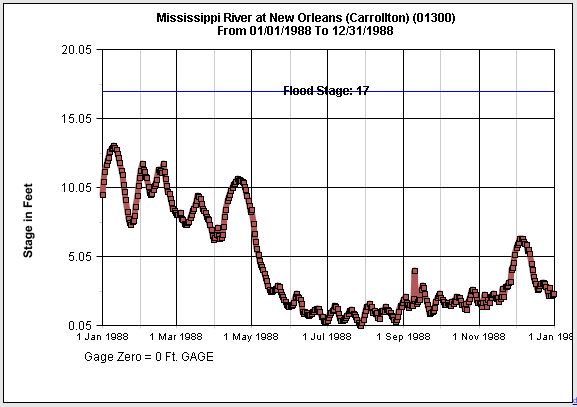
In April '88 the river goes down and stays down. There are no significant rises after that hard fall to re-dirty the surrounding coast.
So that's certainly an encouraging sight, isn't it? What do you think so far? Tell me in the comments below.
Now, at this point in time you may be wondering about other rivers and bodies of water. Let me address that:
The Mighty Mississippi Is An Indicator
Yes, I am using the Carrollton Gauge on the Mississippi River a lot, but I am doing that because it serves as something like a speedometer to paint the overall picture of what was happening on Louisiana's coast, to include Sabine and Big Lake and Vermilion Bay.
Simply put, if it was wet on the Mississippi, then it was probably wet on all the other rivers, too!
With that out of the way, let's press on.
I can say, anecdotally, that the speckled trout fishing has become somewhat better, and that we are seeing species more reliant on saltwater begin to make a comeback in fishing reports.
These include, but are not limited to: flounder, channel mullet, white trout, pompano and spanish mackerel.
Trout Limit Chicanery
This is one reason why I never really made a fuss when people were up in arms over the trout limit being lowered.
While that debacle is worthy of a very long article, I felt that the decrease in trout fishing we were all experiencing was more a function of the absurd amount of flooding experienced on our coast and that, once the flooding ceased, we would see the fishing return to its previous status.
In short, the issue occurred (and could resolve) in a geological blip of time that whining people on social media don't have the attention span to comprehend.
But, with that said, I do think that we hammered the trout pretty good during the Freshening and that we'd do ourselves a service to let these fish recover.
After all, we all enjoy catching them more so than we do eating them.
So, with that out of the way, there is another point that needs to be addressed:
The Often Overlooked (but critical) Aspect Of The Saltening
As much as I have been using the terms "salt", "saltier", etc. I do not want to mislead people into thinking that just because our coast is saltier that things are inherently better.
Many inshore anglers on Louisiana's coast already possess this weird cultural thing that just because salinity is up that things are better.
People do this to such an extent that they literally cheer on hurricanes and tropical storms for "raising the salinity" (though these storms do no such thing).
Obviously that's idiotic and ill-informed, and you can understand why I wouldn't want to stoke those flames.
Instead, I'd like to point out that the most important aspect of The Saltening is not so much that the salinity is up, but that river water is down.
River water is dirty, blocks sunlight and can over-fertilize, leading to algae blooms.
I'd argue that the most important aspect of The Saltening is not that coastal bodies of water have risen in salinity, but that coastal bodies of water have cleared up because dirty water is no longer being poured into them at a significant rate.
Remember, speckled trout do fine in low salinity water and so do redfish!
We very well could call The Saltening something like "The Clearering" instead, and still be accurate.
Either way, it's my intention that — as you read this article — you do not become a zealot of salinity but instead a disciple of the broader and more well-informed picture of Louisiana's coast.
What Can We Expect The Saltening To Bring To Louisiana's Coast?
We can expect everything that was lost during The Freshening of 2011 to 2020 to be recovered during this Saltening currently happening in the 2020's. That's just a hopeful assumption.
Things like viable oyster reefs and speckled trout spawning grounds are bouncing back. We see this anecdotally.
But, this is not the first time we've had a "saltening". Yes, this coastal phenomena has happened before and we can look to the past to get an idea as to what is to come.
That timeframe was over 20 years ago. We must go back to the year 2000. Great Scott!

What happened during Y2K?
The time leading up to and after the Year 2000 was a "saltening" event that preceded the one we are currently entering.
You could say that it starts in 1992, when the Mississippi River didn't get above 12 feet, or in 1997 after the Bonnet Carré Spillway was closed. Then, you could say that it ends in 2008 with the opening of the same spillway, or in 2011 when our recent Freshening began.
It's up to you, but what is undeniable is what happened from 1998 to 2007.
Mississippi River Annual Levels 1995 to 1999
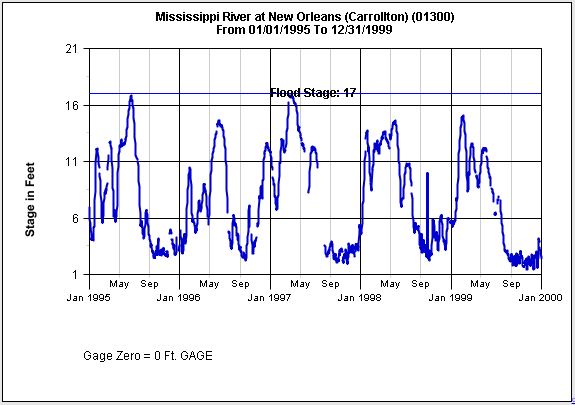
Mississippi River Annual Levels 2000 to 2004
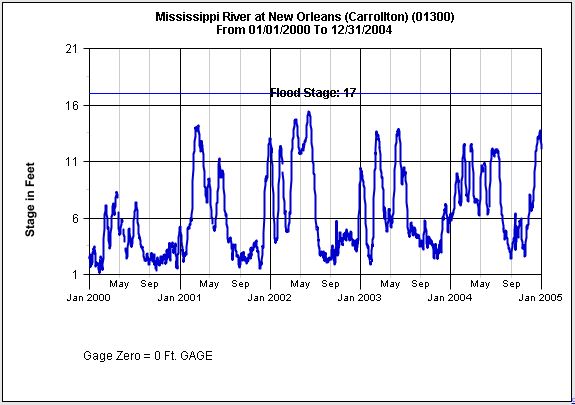
Mississippi River Annual Levels 2005 to 2009
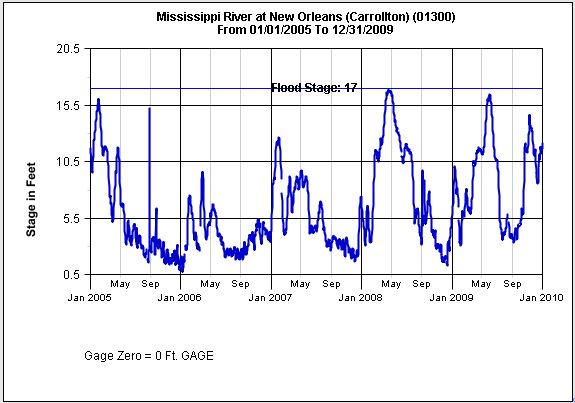
First, beginning in 1998, the river never got near flood stage then, in the year 2000, she never got out of the single digits.
After that, she didn't come near flood stage again until 2008, and spent a good deal of time in the single digits.
Now, what did this result it? Before jumping into that, let me detail a key point:
Wouldn't the 1997 flood have affected the Y2K Saltening?
Yes, there was a spillway opening in 1997! But it really wasn't that big of a deal.
The Bonnet Carré Spillway was only open for 31 days in 1997. That pales in comparison to the 237 days of The Freshening:
I cannot say for certain how much river water in an area impacts it for however long (don't we have tax dollars and actual scientists to do this?), but it doesn't take a Ph.D. to see the obvious difference between 31 days preceding a span of 11 years versus 237 days distributed in nine.
The Result of the Y2K Saltening:
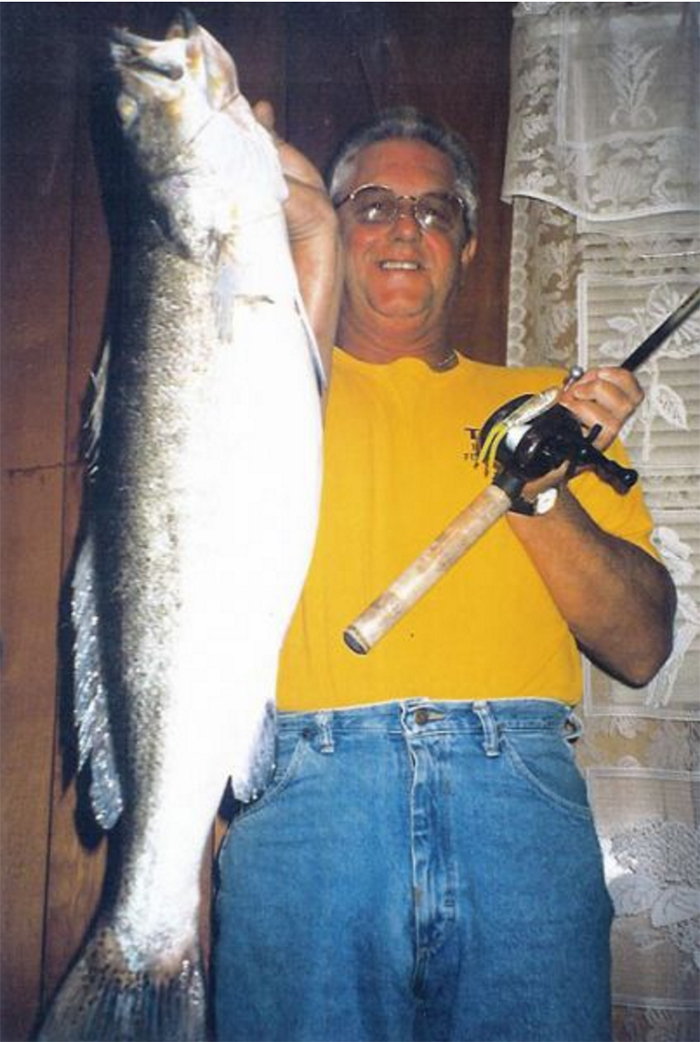
Kenny Kreeger with his massive 11.99lb speckled trout caught January 1999
This was the time when state record speckled trout were hitting the scales with a regular frequency measured in months and single-digit years.
If you don't believe me, just look at the top ten state record speckled trout: out of ten entries, seven of them came from the late 90's and early 2000's.
Yes, even during the 90s — specifically in 1992 — the river was behaving itself, lending to good fishing.
I was alive then, going fishing with my brother and father. Now, understanding that fishing trips become better with time — and that the memory fades — I do recall it being easier to catch fish.
After all, we were running around in a ding-a-ling flatboat with a small gas tank and no GPS, not to mention also lacking the other amenities that we enjoy today, like spot-lock trolling motors and shallow water anchors.
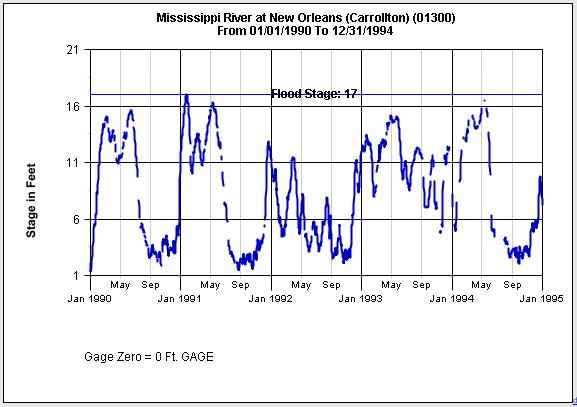
One could argue that the Y2K Saltening has its roots beginning in 1992.
We didn't have those tools (that make fishing so much easier) but yet we still caught limits of speckled trout and redfish.
Comparing that old boat to the one I fish today is like comparing a coracle to an aircraft carrier. It's not even close.
Yes, I still catch fish, but I'll admit that it's harder today than it was then.
Yet, I am excited! And that's because we very well could be in the beginning stage of what will amount to be an epic time in inshore fishing.
And what's crazy is that when you browse fishing report forums and digital creators, none of them are talking about this!
But, perhaps it is now when I need to lower my volume and cover my ass:
Beware: This Is All Just My SWAG
You need to know that this entire article is only my SWAG, or Scientific Wild Ass Guess.
At the end of the day I'm just some guy who really likes inshore fishing and was fortunate enough to figure out a way to make a living from it.
Along the way I picked up some useful insights and learned more than I otherwise would have, but I am no scientist.
My researching this topic only made this more clear: there's so much I don't know and do not comprehend.
Additionally, I cannot predict the future, and chances are I could be looking at this "saltening" concept incorrectly. For all I know, the Mighty Mississippi could topple levees and wipe out civilization next year, much less inshore fishing.
What you've read so far may only be misplaced optimism magnified by a lens of blissful ignorance.
You've been warned.
Are you really prepared for the saltening of Louisiana's inshore fishing?
Given my warning that I could be completely wrong, let's get a little crazy , go out on a limb and pretend I'm onto something:
What does this "Saltening" mean for Louisiana's inshore fishing? Most importantly...
...what does it mean for you and your fishing trips?
Well, if the fishing is going to get better, then that means we will all have fun catching more fish, more often.
And I guess that's it. But, when considering this saltening a little more deeply, I arrive at a few things:
Firstly, we inshore anglers got a black eye in the last ten years and learned the hard way about conservation. This didn't happen just in Louisiana, but the Boot State was certainly a part of it.
Whether that's Speckled Truth's Citation Program, Release Over 20, TAG Louisiana or the many other conservation initiatives that have sprung up in this new millenium, we now have a growing group of anglers wielding an appreciation for catch and release.
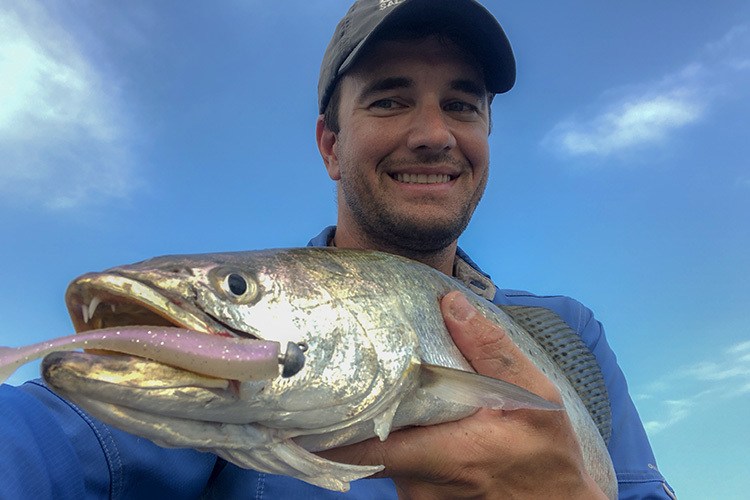
I think that your shot at catching a real wall-hanger is a possibility in the years to come. I can teach you what you need to know to meet that challenge.
We are moving forward into another saltening, but this time with a pronounced catch & release mindset that could see records being broken, and those records will most likely be broken by the anglers who adapted to The Freshening and did well catching fish under those tough conditions.
I'll make it simple: if you were a lousy live-bait angler frequenting community holes in the last ten years then you cannot expect to reap the benefits of a saltening as much as the anglers who took time to master new techniques and locate their own fish.
Yes, you will catch more fish. No, you will not catch that state record.
There's more to being a samurai than swinging a sword, and there's more to inshore angling than using generic fishing tackle and tactics.
I think what is required to capitalize on The Saltening is a holistic understanding of the marsh, how it came be, how the fish use it and, of course, a proven process to locate and catch fish based upon the conditions predicted for the day of your trip.
This and more is what I teach inside Inshore Fishing 101 as well as other courses inside LAFB Elite.
LAFB Elite is great. I earned a lot and look forward to putting that knowledge to use!
Also, I love being able to go back into the courses and refresh what I’ve learned before and after trips in order to see what can make the next trip better.
I may only get to go a few times in a year so I need to make the most out of my trips!
I love that Captain Devin puts himself in my shoes as an amateur fisherman.
This ensures great clarity and keeps me from having to go look up something to try to figure out what he is talking about.
Over To You
There may be something ahead we don't know. There are questions I know that I have, but do not yet have answers for.
Maybe the fishing will suck. Maybe it won't bounce back. Perhaps there's some kind of unforeseen consequence of The Freshening that we have yet to discover.
I do not know. Perhaps time will tell.
But I do know that, by now, you may have an opinion or some kind of insight to offer.
I value such things and that is why on this blog I feature a carefully crafted comments section where you can chime in. You'll find it below.
Thank you for reading!

Great questions, Dennie! I’m so glad you put them here.
Well, first off, hatcheries for redfish and speckled trout don’t work. They’re a political farce. Specks and reds are not bass. Captain Ty Hibbs has spear headed this and revealed to me a lot about the survival rate of hatchery raised fish, how expensive and ultimately futile is. He has a podcast or two coming out regarding this issue. The next problem I have with hatcheries is that it takes a natural process and puts it in the hands of man, inevitably leading to its politicization. What could possibly go wrong?
After that, if we have to put our fishery on life support in such a manner then I’d rather find something more ethical to do.
Thank you for commenting!
I no longer live in Louisiana as a result of my retiring and my wife continuing to work in the nursing field. I was a “fanatic” fishing for bass and also speckle trout, redfish, flounder. I was good enough to assist many friends and family in catching fish. I gained a reputation and was asked to guide – no thanks, I did that as a duck/goose hunting guide. GOD blessed me with a talent and I used it to the best of my ability. I caught a speck that was over seven pounds and that’s before the lake had ten pounders in it. YEARS AGO. I’m in my 70’s now. I have lived in Texas, Georgia and now Arkansas. I was also a member of DU and GCCA. My point, “Why have we not put “hatcheries” in for redfish and speckle trout. Yes, I understand salinity and I believe it shows it has an impact. Hurricanes bring “WATER” and that drops salinity. DA! There are so many places to put hatcheries like below where I lived, -Lake Charles, LA. They are; Grand/Big/Calcasieu Lake, Vermillion Bay on to those further east. People come to Louisiana to catch saltwater fish. It’s a great attraction for tourism and a bounty for those in business, also. Will someone “start” this initiative and with the wealth this state has, invest in an element that will increase tourism that + adds money to state coffers, LWF, guides, restaurants and other businesses – etc., etc., etc……… Thanks DJL
Thank you, Jerry!
Thanks for supporting LAFB Elite, Mike!
Capt. Devin, thanks for taking the time to do such good research and open the eyes of people who care enough about our natural resources to take the time to read it. You do a great job of presenting a lot of valuable information without having any agenda other than making people smarter about fishing. I not only catch more fish having been part of your club for three years, but I have more fun doing it because I understand the ecosystem so much more.
I think you are correct on the past and current trends, and your saltening theory, and do think you are correct on the possibility of fishing overall , getting better as this trend, or” pattern”, shall we call it, of saltening, continues in the direction of past patterns. But, may i remind all of us that good ole “ Mother Nature “ is the only one that really calls the shots in the grand scheme of “patterns”, and that could change in the blink of an eye, so we shall see. But I’m with you and lots of others, who have benefited from learning from your courses and hopeful the things we have learned, will be able to be used effectively for years to come, and hopefully these patterns of change will enable all of us to learn and teach new generations to come, about the great ups and downs of a fishery that was, and can still be a great place to be !! Its all about learning, we all need to pay just a little more attention. Thanks for keeping us all a little more focused on the ways of mastering what we love to do !!
Thank you so much, Robin!
Amazed at your detailed analysis, and appreciate your honesty about it being an educated guess. I’ll say that it’s the MOST educated guess I’ve ever read-keep up what you’re doing, brother. It’s helping a lot of us out here!
Being there in Kentucky you’re much closer to world-class bass fisheries but still make time for Louisiana. Thank you so much for that. I’m glad you’re able to come down and enjoy yourselves! March is a long time to wait, but it’ll be here before you know it. Thanks for reading!
As an out-of-stater, I really enjoy your blog. We try to make 1-2 trips per year from Kentucky and have since 2014. Your blog and the YouTube channels we watch keep us “in the loop” between trips. Reading this entry has me fired up, though my next trip isn’t until March next year. Thanks for such a great resource!
Thank you, Steven!
Thanks for reading, Emmet!
It’s very good to have you here, Jon.
I don’t know if there’s an upper limit of temperature for speckled trout spawning. I couldn’t tell you, nor do I have any information regarding the summers being so much warmer that it would affect their spawn and, if I did, I don’t know how that compares to other pressures.
I’m not contesting your claim, I’m just saying I don’t know. I am ignorant.
As for the sharks…all I can say is that, anecdotally, there have been far fewer sharks that I have personally seen since the days before the bulk of the Freshening (I’m thinking of 2009-2013 in Breton and Chandeleur Sounds). In Breton Sound they were (and are) a fact of life. I’d say your shark experience is “normal”, but I don’t know that we have any accurate counts of sharks to really ascertain anything beyond personal experience.
I’d say the same thing for dolphins: there’s always been enough of them to be a nuisance. People think they’re cute and cuddly. I do not. LOL I’m sure you have similar feelings.
Also, I really appreciate your stance on speckled trout. It really reflects in your content and especially YouTube videos (which I recommend anyone go enjoy) :)
Thanks, Toby. I appreciate your taking time to visit and THANK YOU for supporting this website by having joined LAFB Elite!
All excellent observations. We live on a riverine estuary. The river is responsible for it all, and controls it all. The main factor in how many trout the estuary can support is in direct relationship to how much marsh it has. Open water is far less productive to areas with cover. Marsh is important for juvenile trout to grow and survive. The yearly classes of trout will be larger in areas that still hold marsh. When I was young, there was no limit on trout or redfish. Success was measured in ….ice chest. One ice chest was not a great trip. 3 ice chest was….and you could catch them in just a couple hours. Those days are gone in most of our estuary. Need …marsh.
I agree with you, the best fishing was in 1992through 2008. Me and my fishing buddy would go fishing and catch 50 and 10 several times a week and at different times and places and catch our limit. and it got to when we start out he would ask me how man76y fish i wanted to clean and i would say 12 and he would say 8 and when we got to 20 we would stop and go in. today it not like that. so a am agreeing with you.
Great article Devin. You are a most impressive writer in addition to a pro inshore fisherman. I have fished a long time and have caught my share, but, simply put, I have become a much better fisherman since joining LAFB. The older I get, the more I want to learn the hows and whys I caught or perhaps didn’t catch on a trip. The “science” of it all never gets old to me. Additionally, my conservation efforts have also gotten much better. Maybe that’s an age thing ;-) Thank you for sharing your knowledge. Tight lines Cap
Nice research and thoughtful analysis Devin. I agree that the Mississippi River is the biggest influence in our fishery. I would love to see the days of plenty return but I am skeptical that the fishery can return to the per 2000 abundance. There are several factors that I think may depress the recover numbers including increasing summer water temperatures (pushing trout out into the more dangerous Gulf waters), more anglers with the ability to reach the trout wherever they are (agreeing with you there), and starting at a very low Spawning Stock Biomass.
Does it seem like there are more sharks these days? I was amazed at the high numbers of smaller sharks this year compared to the LA MLL, which is around 54″ for most species. (Who wants to keep a 54″ shark?) The protection of sharks I’m sure was necessary but if they are allowed to overpopulate, the specked trout SSB will certainly suffer.
We also have a huge population of dolphins. I was amazed at how few dolphins are on the undeveloped Nature Coast of FL compared to the LA coast. We are truly blessed with an abundance of marine life on our coast. Our marine ecosystem should balance itself naturally but when the trout SSB starts so low, then an abundance of these large predators (including anglers) may cause it to level out at a lower level than we would like.
I am one of the anglers you speak of who started releasing all the larger trout I caught starting several years ago in response to the decreasing numbers and size of the trout I was catching. I will probably continue to do that until the 20″ speckled are as common as mullet. Like you say, I got conditioned to harvesting the 12″-17″ trout, and now it seems unproductive to keep a 20″ trout.
Thanks again the stimulating article.
Capt. Rory, it is an honor to have you here commenting. Thank you so much.
I agree with what you’re saying, 100%! The trout spawns didn’t get a chance for the last ten years. The whole time people were blaming everything but the river water, LDWF’s chief biologist even blew it off. When I emailed him about it, I got no response, unfortunately. But I don’t think one can honestly assess the trout population without factoring in The Freshening.
I’m glad you’re sharing your good memory with us here, because the freezes are an important aspect not included in this article. There was a Texas-based speckled trout book I read awhile back, and it detailed how, after a bad freeze, they’d find dead trout washed up on the shore. But, what was interesting about the dead trout, is that their gills were packed with mud. They couldn’t clear the dirty water out of their gills because they were so lethargic due to the freeze.
So that also made me wonder how many trout die at the bottom of deep holes and we just don’t know about it. I cannot be certain. I will probably die not having figured it out. I will probably go to the grave having not uncovered many questions I have about the marsh and speckled trout.
Anyway, it is a pleasure having you here because you’re one of the original guides who can actually catch limits of speckled trout and remember what it was like before The Freshening.
Too many people have a short memory and we should guard against that. I think the fishing will get better.
Thank you for reading.
You’re welcome! And thank you for reading, I appreciate your taking time to do so.
Thanks for all the information and insight Capt. Devin.
Capt. Devin, you know I am old enough to know all about the good old days, and also the not so good old days before. In the late 80’s and early 90’s we had to deal with a few massive fish kills due to severe freezes. It was so bad many gave up on salt and focused on fresh. With the beginning of the last saltening, the trout population exploded. Mother Nature will always fill a void. With that said I think we are on the verge of a great comeback in trout and redfish numbers.
I believe it is the saltening and not the clearing that will bring back fish numbers back. During the freshening we also had a couple freezes that killed some fish, but not to the levels of the 80’s-90’s. In that time we lost several spawning classes of trout and reds. Sure they can live in the fresher water, but spawn they can not. They were forced to spawn so far out the eggs never had a chance to make it back into the marsh and when and if they got there the water was too fresh for survival. The entire east side of the river used to be a major spawning ground and for many years of the last decade this area was too fresh for successful spawns.
I am looking for this new saltening cycle to bring trout and redfish populations back to somewhat of what they used to be. You think you hate a void. Mother Nature hates it even more and always fills it when given a chance. Now if we could please get rid of this howling west wind.
Thanks for reading, Wesley!
Wesley, I think that outcome with frozen fish fillets is more prevalent than what we Louisianans care to admit. It’s a problem and I wish people would see the value in putting fish back in the water, since catching them is what we really enjoy, not eating them.
Spot on Devin, 15 fish is plenty. I got a buddy that has to hit the limit every time. Yet has fish in the freezer that gets freezer burnt cause they didn’t eat it. It doesn’t make any sense.
Great Blog Devin! From looking at all the historical stats it appears to be mother natures cycle in her own time. Couple that with man’s influence and it affects things more in each portion of the cycle. I believe you are correct in that going into this cycle the mindset of a lot of fishermen is definitely different than in the past. Thank you for putting all this together and getting the word out!
Yeah, the reports coming out of the V-Bay area have been getting better and better. Thanks for reading!
Spot on. I really have witnessed this first hand fishing the Cote Blanche and Vermillion Bay areas.
November 1st 2022 I caught over 50 trout solo in Cote Blanche. Not common for this area but I see it getting better if the “saltening” continues.
I’m not saying I’m opposed to dropping the limit, I’m just saying that I think people were misguided and failing to see the bigger picture. I’m alright if the limit dropped to fifteen. That’s still a lot of fish to eat!
Thanks for reading!
I’m just fine they didn’t drop the trout limits and maybe the fishing will come back the way it was before all this river water. Great blog thanks for posting it.